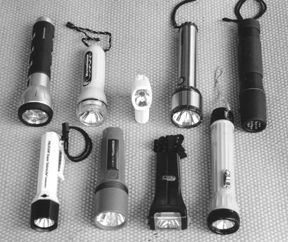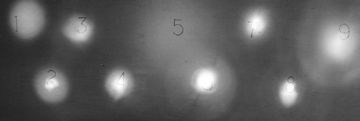
When Practical Sailor last looked at flashlights (March 2000), it was an exhaustive and very detailed review of those that used light-emitting diodes (LEDs). Closely examined and tested were 17 different models, which used from 1 to 24 LED bulbs, and ranged in price from $20 to $300. The best overall in that test was the $60 Tektite Expedition, but much has changed in four years.
Much earlier (in the May 1, 1997), PS was the first national publication to recognize the utility of LED bulbs. That report resulted from a tip from a reader, Rob Hoffman, a Nashville, TN, architectural photographer who was among the first “techno-putterers” to cluster the amazing little electrical devices. Three years later, in the May 15, 2000 issue, PS reviewed Hoffman’s FirstStar, a 12-LED masthead light requiring only a 50th of the power of an incandescent masthead light.
As mentioned in our PS Advisor last month, LEDs have been around a good long while, being used mostly for tiny signal, locator or on/off lights on radios, instruments, telephones, automobile dashboards, etc., but they’ve quietly been evolving.
LEDs in large batches are seen everywhere these days, notably in traffic lights and automobile tail lights, clustered in large numbers to make them produce a lot of light. The simple physics of the individual LED dictate its small size. When PS first wrote about them, they came only in the mathematically-pure color red (which has a wavelength of 610 to 700 nanometers), again a matter of the physics involved. LEDs now are manipulated to get other colors.
Progress continues in LED development, but it’s still just a bit of crystal that serves as a p-n junction that emits light when the junction is forward-biased. Nothing to it. They’re rugged, last forever (as far as is known), produce little heat, and use laughably small amounts of electricity, which would seem to make them ideal for flashlights.
That easy-on-the-batteries facet is what recently caused Gary Burningham to write PS, saying that his company—Lightwave, of Chula Vista, CA—makes the “brightest, longest-lasting and most efficient” LED flashlight.
“I’ll send you our Pro4000,” he offered. “Test it and you’ll find it’s the best flashlight available.” (In PS’s experience, folks in California seem prone to issuing challenges. Must be the diet—avocados and artichokes?)
However, challenges being fairly irresistible, PS rounded up a motley batch of flashlights—old and new—for an informal shooting match intended to determine which flashlights are (1) the brightest, and (2) the longest-lasting, with emphasis on the latter. With current technology, the only way to make an LED flashlight brighter than a krypton or xenon bulb model is to use a lot of LEDs.
Since practical is the name of the game here, we opted to test old vs. new, “techy” vs. well-honed conventional, and big vs. little.
The flashlights in this mixed test are identified in the accompanying chart, numbered and listed alphabetically by maker, along with details about each. They appear in that same order in the photos—arranged in a double W (see photo, top of page).
Several are plain old flashlights in modern dress, the likes of which have been around for years. They’re relatively inexpensive. A good old vs. new match-up pits Eveready’s new Watersport model against Rayovac’s venerable and rightfully-famous Rough Neck (perhaps the most rugged flashlight ever made).
Two of the flashlights are truly old. The very versatile Streamlight Top Spot, which was first recommended by PS in 1991 after a reader, Alexander Beller, pointed it out as the “only flashlight you’ll ever need,” has been in household use, unchanged except for batteries, for about 10 years. Even older is a plain old yellow-cased, three-cell West Marine Sealine purchased long ago when Randy Repass, the millionaire CEO of West Marine, was operating his then-new business out of a little warehouse on the north side of Boston’s Logan Airport. “Old Yeller”—still working fine—has been used for years on boats owned by a PS staffer.
The more modern models include several with Krypton or Xenon bulbs, a Garrity Life Lite throw-away (said to be popular with firemen), and two, in various configurations, with LED bulbs, including, of course, Mr. Burningham’s spanking new Lightwave Pro4000 (as well as the Brinkmann Rebel).
The Test
To check Mr. Burningham’s claim of “brightest” and “longest lasting,” all 9 flashlights were equipped with new Panasonic Digital batteries—all purchased at the same store and hopefully from the very same batch. In the case of the three old flashlights—the Rayovac Roughneck, Streamlight’s Top Spot and Old Yeller—none was equipped with new bulbs. That decision ran the risk of having a bulb burn out in the midst of the test, but because the existing ones had lasted for years, we asked, why change?
A simple plywood panel painted flat white was rigged to show comparative brightness, display organized beam patterns (it’s called collimation, meaning the light beams are parallel), and to demonstrate what happens with continuous use. Based on past experience, and as plainly stated by some makers, some lights will begin failing within hours. However, if Mr. Burningham’s claim of 900 hours for his Lightwave Pro4000 is true, the test will take 37-1/2 days. (We concede that these flashlights probably would yield longer lives if used intermittently, but we felt a continual test would still yield useful results.)
It’s understood that no one expects a flashlight powered by two C cells to outshine or outlast a 3-D flashlight. Further, a 25-year-old flashlight with an old incandescent bulb (West Marine’s Old Yeller) can’t possibly be as bright as one with a xenon bulb.
Or can it? Let the light games commence.

Comparative Results
For brightness, nothing equaled the slim, Pelican Super Sabrelite powered by 3 C-cells. Next brightest was the 2-D Garrity SS, another conventional flashlight with a Xenon bulb. Surprisingly, third for brightness was the tried-and-true 2-D Rayovac Roughneck, which has the same Krypton bulb that it came with a few years ago. Fourth was Eveready’s Watersport, a well-sealed and very light modern flashlight that is slightly flawed only by its twist-on, twist-off switch. Twist switches make waterproofing easier, but they require two hands to operate.
The two flashlights with LED bulbs, the Brinkman Rebel, which can be operated on 2 or 4 of its LEDs, and the Lightwave Pro4000, cast a very blue light, which did not compare well with the white light emitted by the others. As shown in the photo, the Brinkmann Rebel’s beam is well concentrated into a good round spot; the Lightwave Pro4000 throws very wide light rays that appear diffused and not nearly as bright as most others.
Judged tops for collimation (the concentration and shape of the spot), was, again, the Pelican Super Sabrelite, with the old Rayovac Roughneck second, the Eveready Watersport third, and Garrity’s SS fourth. The Brinkmann Rebel’s spot was a near-perfect globe, but was much larger than the top four.
How long do they last when in continuous use? The manufacturers’ claims—and what really happened—are shown on the chart, except for the Lightwave Pro4000, which was still shining when we wrote this. PS testers checked the board every 30 minutes, for the first 12 hours, and thereafter every 8 hours.
The first to nod off was the old Streamlight Top Spot. With 4 AA batteries (the least power of all), it lasted just 2-1/2 hours. Next to fail, and very suddenly, at 4-1/2 hours, was the otherwise stellar performer, the Pelican Super Sabrelite.
Of the two LED flashlights, the Brinkmann Rebel, operating on four bulbs, packed it in at 69 hours, just short of three days. It remained fairly usable throughout the time period. The duration for the others is shown on the chart.
As expected (with bulbs not part of the consideration), the more batteries and the bigger the batteries, the longer the flashlight makes light. A flashlight with 3 D cells will outlast a flashlight with 3 C cells. Note that the old West Marine 3-D flashlight outlasted Pelican’s 3-C Super Sabrelite, which won both the brightest and best collimation categories.
That makes it folly to believe any manufacturer’s claim that its tiny flashlight will outlast all others, except for the new flashlights with LED bulbs. They’re not very bright, but they do use very little power.
Several of these flashlights (like the Garrity Life Lite), after appearing to have gone dead, recovered a bit after several days, but shone very dimly for only another hour or so. That’s something to remember, however, in an emergency.
After the first week of testing, PS decided to proceed with this report. At the one-week mark, the Lightwave Pro4000 had dimmed considerably, but still was making enough light to read a chart, if the light was held not more than a foot from the paper, and might possibly help you avoid hitting a telephone pole if you were out for a walk on a dark night.
So, Mr. Burningham, it’s not the brightest by far, but you do have there a long-lasting flashlight.
Bottom Line
There probably are several thousand varieties of flashlights on the market. Among them are those you strap on your head, like a miner’s lamp; those intended to beat some sense into sundry miscreants; some you crank; some you shake; some combined with radios; swivel-headed; solar-powered, you name it, they make it. But what you want and need on a boat, for simple safety purposes, is a flashlight, preferably waterproof, that is very reliable and fairly bright, for seeing the masthead, checking a leaky through-hull, spotting buoys, and maybe even to signal or read a real paper chart.
Dry-cell battery development has been remarkable, but in the realm of bulbs, despite the success here and there of LED bulbs, the older types—krypton, xenon, and plain old tungsten wire filaments—continue to outsell LED-bulbed flashlights. Krypton and xenon bulbs are gas-type bulbs, cousins to fluorescents; the other gas-type bulb uses a halogen gas, but halogen bulbs get so hot nobody really loves them.
Resembling the turn-of-the-century AC/DC war waged between Thomas Edison and General Electric, on one side, and Nicola Tesla and Westinghouse on the other, the LED vs. all others bulbs battle continues.
Because the LEDs use such tiny amounts of power, they’re sure to win. But they’re not yet bright enough.

]For the nonce, the inexpensive Rayovac Roughneck is PS’s choice of a reliable flashlight for use in a marine environment. It works; the 2-D model gets a reasonable duration out of the two D-cells; it’s waterproof, and it’s reliable, all of which make it a priority safety item. (The Garrity SS outlasted the Roughneck, but doesn’t claim to be waterproof.)
If you want something to slip in your pocket, the top-ranked (for brightness and collimation) Pelican Super Sabrelite would be our choice.
Because they are so long-lasting, it might make sense to pack one of the LED flashlights in a liferaft or abandon ship kit, if you had room for a second flashlight. Which one? The Brinkmann Rebel (the brighter of the two tested) or the Lightwave Pro400 (the longest lasting)? It’s a tough choice. Just note that the makers say they’re “water resistant,” a term PS has come to distrust.
And what about that Lightwave Pro4000—the one with 10 LEDs? Well, it became unusable after 22 days. That’s well short of the 37-1/2 days (or 900 hours) claimed, but still a long time relative to the others.
Also With This Article
“Value Guide: Flashlights”
Contacts
• Brinkmann, 800/468-5252, www.Brinkmanncorp.com
• Eveready, 800/742-8377, www.E-FLASH.com
• Garrity, 203/245-8383, www.garritylites.com
• Lightwave, 800/305-3902, www.lightwave-USA.com
• Pelican, 800/473-5422, www.pelican.com
• Rayovac, 608/275-3340, www.rayovac.com
• Streamlight, 800/523-7488, www.streamlight.com
• West Marine, 800/262-8464, www.westmarine.com
































